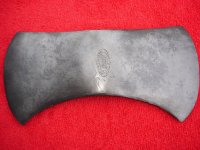Older The Better
Silver Member
- Apr 24, 2017
- 3,378
- 6,661
- Detector(s) used
- Whites Eagle Spectrum
- Primary Interest:
- All Treasure Hunting
Found this axe a while back, gave it a good soak in apple cider vinegar hoping to find a maker I thought I looked it over pretty good and didn’t see anything so I went ahead and hit it with a little grinder stone on a dremmel to knock off all the rough ridges from rust and help prevent future rust. One one pass right up by the end the letters sburgh appeared… I assume it was Pittsburgh





If found this pretty fast with an axe that looked very similar if not the same but I’m suspicious that it was too easy to solve so to cover my bases I’ll throw it to you guys

If found this pretty fast with an axe that looked very similar if not the same but I’m suspicious that it was too easy to solve so to cover my bases I’ll throw it to you guys








